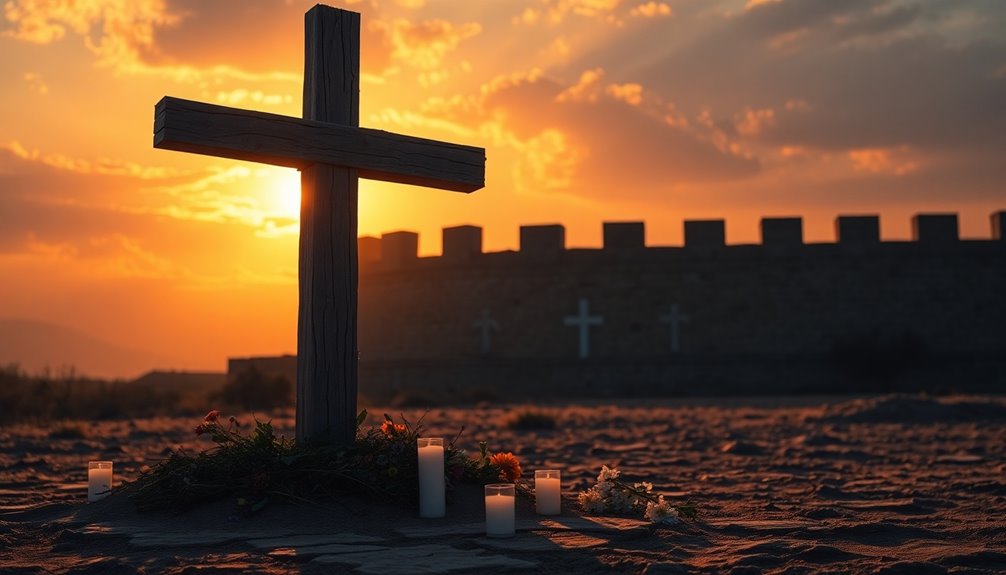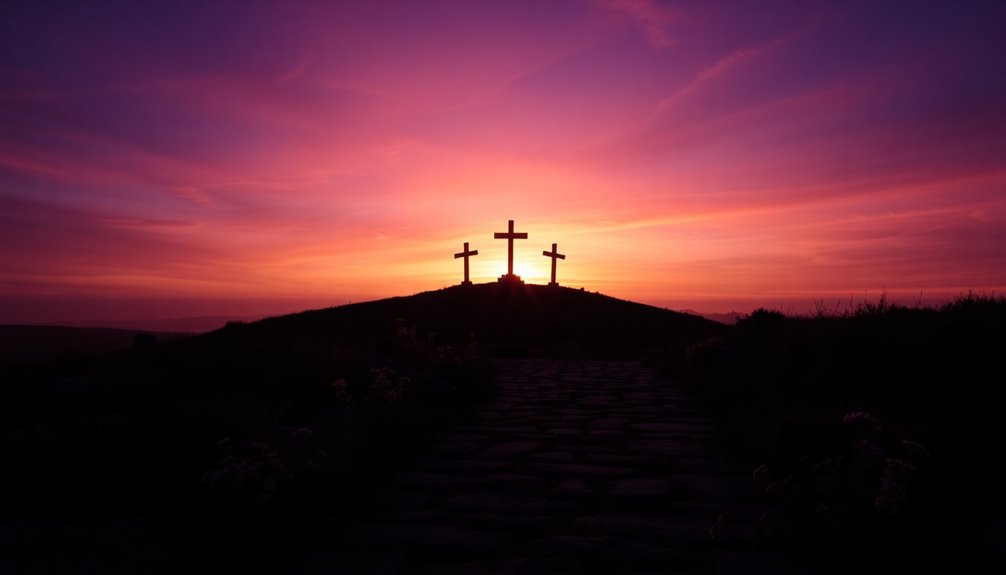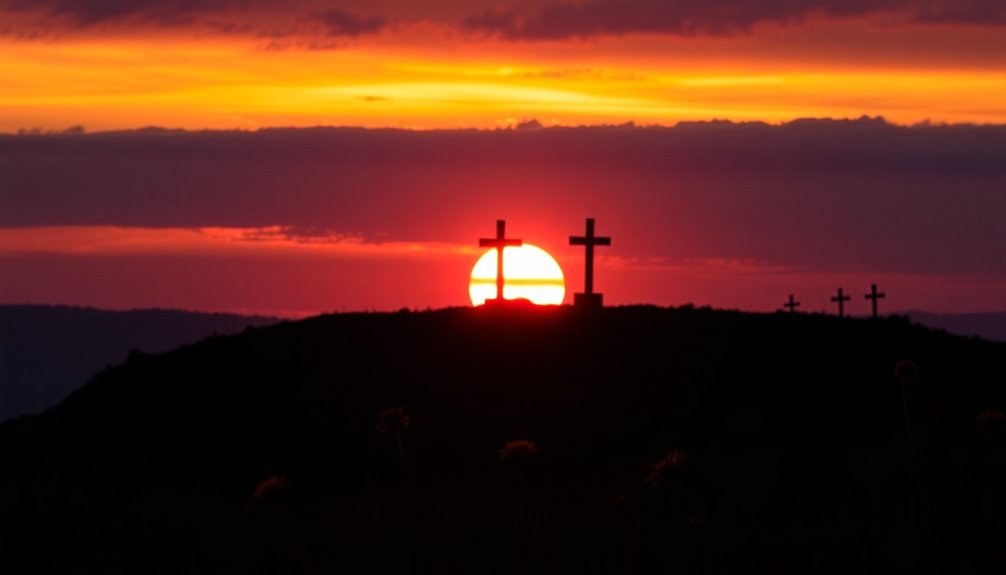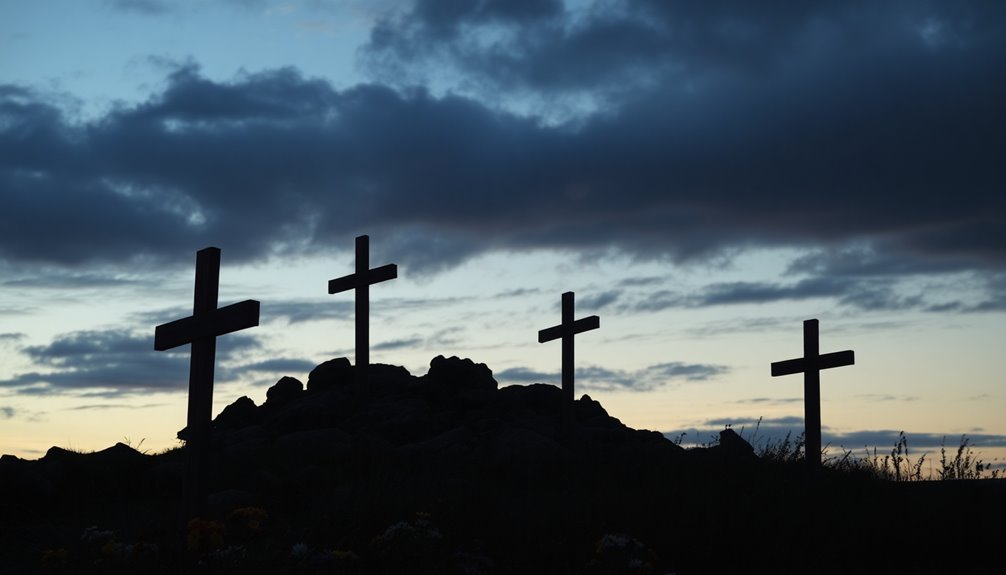Jesus died on April 3, AD 33, a date that holds great significance in history. His crucifixion took place on Nisan 14, just before Passover, aligning with Jewish traditions. The event began at around 9 AM and concluded approximately six hours later, at 3 PM. This aligns with what the Synoptic Gospels tell us about the timing. The day of Jesus' death is often commemorated on Good Friday, symbolizing redemption. Understanding this pivotal moment can deepen your appreciation of its cultural and spiritual impact, so there's much more to uncover about this significant event in history.
Key Takeaways
- Jesus died on April 3, AD 33, which corresponds to Nisan 14 on the Jewish calendar.
- His crucifixion began at the third hour (9 AM) and he died at the ninth hour (3 PM).
- The event occurred on the Day of Preparation before Passover, aligning with Jewish traditions.
- All four Gospels confirm the crucifixion took place just before the Sabbath.
- John's Gospel suggests a different timeline, indicating Jesus died before the Passover meal.
Introduction

Historically, many scholars agree that Jesus died on April 3, AD 33, a date that aligns with the Jewish calendar and the observance of Passover. This significant date falls on Nisan 14, marking the Day of Preparation, when Jesus was crucified. The Gospels tell us His death occurred around 3 PM, or the ninth hour, after hours of suffering that began at about 9 AM.
The Last Supper, depicted in the Synoptic Gospels as a Passover meal, contrasts with the Gospel of John's timeline, which suggests Jesus died before the Passover meal. This discrepancy has sparked scholarly debate regarding the exact timing of these events.
However, all four Gospels agree on the crucifixion occurring just before the Sabbath, emphasizing its importance in the Passion narrative.
Historical evidence, including astronomical calculations, supports the date of April 3, AD 33, as it coincides with a partial lunar eclipse. This event aligns with prophecies of darkness during the crucifixion, deepening the historical and theological significance of Jesus's death.
Understanding these details helps you appreciate the profound impact of this moment in history.
Scriptural Basis for Timing

When you examine the Gospels, they consistently point to a Friday crucifixion, aligning with the Jewish Passover.
Key passages in Mark and Matthew provide specific details about the timing of Jesus' death, while John's account adds a unique perspective.
Primary Bible References
The Gospels provide clear references that pinpoint the timing of Jesus' crucifixion. According to Mark 15:42, Jesus was crucified on the Day of Preparation, which corresponds to Friday, the 14th of Nisan, aligning with Passover. Mark 15:25 states that Jesus was crucified at the third hour, or 9 a.m., and he died around the ninth hour, at 3 p.m., as noted in Matthew 27:46-50.
Luke 23:54 emphasizes that Jesus' body was laid in the tomb just before the Sabbath began, reinforcing that his death occurred on a Friday.
John's account adds a theological layer, suggesting Jesus died before the Passover meal, positioning him as the sacrificial lamb (John 19:14). This detail is crucial, as it underscores the significance of his death in relation to Jewish customs.
Historical context and astronomical data support this timeline, indicating that the crucifixion likely occurred on April 3, AD 33, which aligns with Nisan 14 on the Jewish calendar. Together, these Gospels provide a cohesive and compelling scriptural basis for understanding the timing of Jesus' death.
Secondary Bible References
Building on the primary references from the Gospels, secondary Bible passages further clarify the timing of Jesus' death. The Synoptic Gospels indicate that Jesus was crucified on the Day of Preparation, specifically Nisan 14, the day before the Sabbath (Mark 15:42). This date aligns with the Jewish observance of Passover, establishing a deep theological connection between Jesus and the paschal lamb, as noted in 1 Corinthians 5:7.
John's Gospel reinforces this timing by stating that Jesus' crucifixion occurred at the sixth hour (noon) on the Day of Preparation (John 19:14). This detail underscores that Jesus died before the Passover feast began.
In Matthew 27:46, Jesus' last words are recorded at the ninth hour (3 p.m.), confirming the timeline of events surrounding his death. Mark 15:33-34 describes a significant darkness from the sixth to the ninth hour, emphasizing the profound nature of the crucifixion.
Ultimately, the Gospels consistently affirm that Jesus' death took place on a Friday, marking a pivotal moment in the salvation plan of God, as he became the sacrificial lamb for humanity.
Jewish Passover Traditions

Passover traditions hold deep significance in Jewish culture, commemorating the Israelites' liberation from Egyptian slavery. Celebrated in the month of Nisan, this holiday begins on the evening of the 14th, marking the moment when families gather to observe important rituals.
Passover preparations must be completed before sunset, as unleavened bread becomes a central part of the meal, symbolizing the haste of the exodus.
During this time, thousands of lambs are sacrificed at the Temple, reflecting the ancient practice of offering a paschal lamb. In fact, historical records indicate that over 256,000 lambs were slaughtered in AD 70 alone.
Jesus' crucifixion aligns with these traditions, occurring on Nisan 14, which is significant since he's often referred to as the "Lamb of God."
The Last Supper, traditionally viewed as a Passover meal in the Synoptic Gospels, adds complexity to the timeline, as John's Gospel suggests it took place the evening before Passover.
This ongoing scholarly debate highlights the intricate connections between Jesus' death, the sacrificial lambs of Passover, and the Jewish calendar, enriching our understanding of these pivotal events. Additionally, the rituals during Passover reflect astrological influences that may affect how communities perceive their significance, further intertwining cultural and spiritual practices.
Cultural Impact of Crucifixion

Exploring the cultural impact of Jesus' crucifixion reveals its profound influence across various artistic and literary domains. The crucifixion serves as a powerful symbol of sacrifice and redemption, inspiring masterpieces by artists like Michelangelo and profound musical compositions by Bach. Each year on Good Friday, communities worldwide commemorate this event, highlighting its cultural significance and the rituals that have developed around it.
In literature and film, the themes of sacrifice and moral conflict stemming from Jesus' death resonate deeply, as seen in Dostoevsky's "The Brothers Karamazov" and Mel Gibson's "The Passion of the Christ." The crucifixion has sparked numerous theological discussions, shaping Christian doctrine and leading to a variety of denominations, each with unique interpretations of its significance.
Beyond religious contexts, the impact of Jesus' crucifixion extends into social movements, influencing ethical discussions about justice and human rights. Figures like Martin Luther King Jr. and Gandhi drew upon its historical value to promote messages of forgiveness and reconciliation.
In this way, the crucifixion remains a profound touchstone in both spiritual and secular conversations, reflecting its enduring legacy in our cultural landscape.
Timing of the Crucifixion

When you look at the timing of the crucifixion, you'll notice several misconceptions that need unpacking.
Different Gospel accounts present varying details, leading to some confusion about the exact timeline.
Understanding these discrepancies helps clarify the significance of Jesus' death during Passover.
Debunk Common Crucifixion Misconceptions
The timing of Jesus' crucifixion is often misunderstood, leading to misconceptions that can cloud the significance of the event. According to the Synoptic Gospels, Jesus was crucified on Good Friday, specifically on Nisan 14, the Day of Preparation for Passover, which aligns with April 3, AD 33.
However, John's Gospel creates confusion by suggesting that Jesus was crucified before the Passover meal, sparking debate on the actual timeline.
You might also be surprised by the details surrounding the day of the crucifixion. Jesus was led away for crucifixion around the sixth hour (noon) and died at the ninth hour (3 p.m.). This timeline is crucial, especially considering the darkness that covered the land from noon until 3 p.m., highlighting the event's profound supernatural aspects.
Additionally, historical and astronomical evidence supports the date of Jesus' crucifixion, coinciding with a partial lunar eclipse. This celestial event further validates the timing described in the Gospels.
Timing Discrepancies Among Gospels
Timing discrepancies among the Gospels create intriguing challenges for understanding the crucifixion of Jesus. The Synoptic Gospels—Matthew, Mark, and Luke—suggest that Jesus was crucified at the ninth hour (3 p.m.) on the Day of Preparation (Nisan 14), following the Passover meal.
In contrast, John's Gospel claims that Jesus died before the Passover feast began, which significantly alters the timeline. Mark 15:25 notes that Jesus was crucified at the third hour (9 a.m.), with darkness enveloping the land from noon to 3 p.m., during which Jesus spoke His final words.
John presents the Last Supper as not being a Passover meal, occurring the evening before the crucifixion, which further complicates the timing. Additionally, John emphasizes that Jesus was sentenced to death by Pilate prior to the Passover, diverging from the Synoptic accounts.
These discrepancies have sparked scholarly debates about the historical accuracy of the narratives and their theological implications, especially concerning Jesus as the sacrificial lamb. Understanding these timing issues is crucial to grasping the full significance of the events leading up to the crucifixion.
Faith-Based Community Service

When you think about Jesus' teachings, it's clear that service to others is a vital expression of faith.
Engaging in community service not only reflects His message of love and compassion but also offers you opportunities to make a real difference in people's lives.
Daily Reflections on Sacrifice
Reflecting on the profound sacrifice of Jesus can inspire us to embody His teachings through community service. His death, commemorated on Good Friday, serves as a powerful reminder of selflessness and redemption. As the Lamb of God, Jesus's ultimate sacrifice urges you to act with compassion and help those in need.
During Holy Week, many faith-based organizations encourage you to engage in service activities that honor this sacrificial nature. Each act of kindness reflects the love that Jesus demonstrated, reinforcing the importance of community service in our lives. By participating in these initiatives, you not only pay tribute to His teachings but also foster a spirit of unity and support within your community.
Weekly gatherings often include discussions about the theological implications of Jesus's death and resurrection, deepening your understanding of His message. As you reflect on His journey and the significance of His sacrifice, let it guide your actions.
Embrace the call to serve, and allow the compassion He instilled in humanity to flow through you. Your efforts can make a meaningful difference, echoing the essence of Jesus's love in every act of service you undertake.
Community Service Opportunities
Community service opportunities within faith-based organizations offer numerous ways for you to make a meaningful impact in your local and global communities. By engaging in volunteering at local food banks or shelters, you can help provide meals and support to those in need, embodying the compassion that's central to Christian teachings.
Many churches organize mission trips, allowing you to participate in community development projects that aid underprivileged areas, both locally and internationally. Programs like Habitat for Humanity enable you to work alongside fellow congregants to build homes for families in need, fostering collaboration and a sense of community.
Additionally, faith-based organizations often host clothing drives and donation campaigns, inviting you to contribute gently used items to support those facing financial hardships.
You can also get involved in mentoring programs that focus on youth development, providing tutoring and guidance to foster personal growth and instill spiritual values.
Timing of Jesus' Death

How did the timing of Jesus' death align with important Jewish traditions?
Jesus died on Friday, April 3, AD 33, a date that coincided with Nisan 14, the Day of Preparation before Passover. This timing holds significant meaning within Jewish tradition, as it marks a time of purification and readiness for the Passover feast.
The Synoptic Gospels detail that the crucifixion began around the third hour (9 a.m.), and Jesus died at the ninth hour (3 p.m.), aligning his sacrifice with the sacrificial lambs being prepared for Passover.
Additionally, the Gospels emphasize that this event occurred on the Day of Preparation, reinforcing its importance. On that same day, a partial lunar eclipse occurred, adding a dramatic element to the narrative and fulfilling biblical prophecies about darkness enveloping the land during the crucifixion.
Scholars have debated the timing of Jesus' death, especially regarding the Last Supper and the discrepancies among the Gospels. However, the convergence of these events—the crucifixion, the observance of Passover, and the lunar eclipse—highlights the profound significance of the timing of Jesus' death in relation to Jewish customs and beliefs.
Additional Resources

For those seeking to deepen their understanding of the timing and significance of Jesus' death, a variety of resources are available. You can explore historical texts discussing the crucifixion, particularly focusing on the widely accepted date of April 3, AD 33, which aligns with astronomical evidence and the Jewish calendar date of Nisan 14.
Books on the life of Jesus often delve into the Old Testament prophecies that foreshadow his role as the sacrificial lamb during Passover. These texts highlight how Jesus' crucifixion and subsequent death fulfilled these ancient predictions.
Additionally, scholarly articles may provide insights into the political context of the time, including the reign of Tiberius and its impact on the events surrounding Jesus' death.
You might also consider documentaries or lectures that visually present the timeline and significance of these events, including the darkness that fell during the crucifixion. Such resources can deepen your appreciation of the profound impact of Jesus' death, including the tearing of the temple curtain and the earthquakes that followed.
Engaging with these materials will enrich your understanding of this pivotal moment in history.
Frequently Asked Questions
What Date Exactly Did Jesus Die?
You might find it intriguing that historical and astronomical evidence points to a specific date tied to significant events.
Scholars often suggest that Jesus died on April 3, AD 33. This date aligns with the Jewish calendar's Nisan 14 and coincided with the Passover festival.
The Gospels mention key timings, indicating he was crucified around noon and died by 3 PM, adding layers of meaning to this pivotal moment in history.
Was Jesus Crucified on Good Friday or Easter?
You might've heard that Jesus was crucified on Good Friday, which is widely accepted in Christian tradition. This day is significant because it falls before Easter Sunday, celebrating his resurrection.
The Gospels indicate that his crucifixion occurred on the Day of Preparation for the Sabbath, aligning with the Passover feast. So, while Easter celebrates his rising, Good Friday marks the day he was crucified, making it a pivotal moment in the Christian faith.
What Did Jesus Do at Age 12 to 30?
You might find the "hidden years" of Jesus intriguing, as the Gospels reveal little about his life between ages 12 and 30.
During this time, he likely lived a typical Jewish life, engaging in family and community activities. You can imagine him working alongside Joseph as a carpenter, adhering to Jewish customs and traditions.
Though the specifics are unclear, it's believed he was preparing for his future ministry during these formative years.
Why Did Jesus Die at 33?
Jesus died at 33 because his teachings and actions challenged established religious and political authorities.
You see, his ministry, which lasted about three and a half years, emphasized love, forgiveness, and repentance. This radical message threatened the status quo, leading to his arrest and crucifixion.
His death during Passover symbolically linked him to the sacrificial lamb, fulfilling prophecies and reconciling humanity with God, making his sacrifice profoundly significant in Christian theology.










